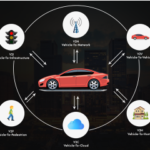You may have or have not heard of Vehicle-to-Infrastructure (V2I) communication. However, there are good chances that you would have heard and read about wireless cars, or as we can say self-driving cars.
The basic concept behind the self-driving cars is to make safe autonomous vehicles with advanced responsiveness that will lead to excessive reduction in road and traffic accidents and mishaps. Similarly, Vehicle-to-Infrastructure (V2I) information is all about making advance all the relative structural components on the roads that cater to traffic functions.
What Exactly is V2I Communication?
Basically, it is about the exchange of data and information between vehicles and the road infrastructure. In today’s times, with advancing technology, data and digital network is the base of advancing concepts, and this is the same for self-driving cars as well as V2I communication.
How V2I Works?
Road safety is a two-way concept – it is the relation between vehicles and the road infrastructure components including traffic signals, road signs and markings. V2I communication works through transfer of information between these infrastructural components and the vehicles via wireless and bi-directional method. This exchange of timely and precise information leveraging software, hardware and firmware system helps to ensure seamless mobility and enhanced safety.
Why V2I is Important?
Everyone wants to feel safe driving on the roads. And with self-driving cars ready to make inroads into our lives to improve the road safety aspects, this revolution can fully take the form of reality if the system surrounding the vehicles on the road also develop progressively.
V2I Communication Development – Moving Road Infrastructure from Analog to Digital
The first and basic thing that needs to change is the road infrastructure. If the Vehicle-to-Infrastructure (V2I) has to take place the road systems have to move from analog to the digital. The new levels of automation and innovation mean lesser dependency on the driver and more on the vehicle system and infrastructure set-up.
The infrastructure arrangement has to be digitally evolved, which would mean moving from the analog system (that is designed to be interpreted by human only) to the digital system (that will be designed to interpret information rendered by the surrounding).
An efficient Vehicle-to-infrastructure communication and process will be one where vehicles and surrounding elements will be fully connected, and thoroughly outfitted that can impeccably transfer information about traffic snarls, crashes, road curves, and recommended speeds. Some dynamic aspects like speed limit, traffic diversion can also be changed as per the external factors like weather and more, ensuring smooth passage for the vehicles.


Oh my goodness! Amazing article dude! Thank you, However I am going through troubles with your RSS. I don’t know the reason why I can’t join it. Is there anyone else getting the same RSS problems? Anybody who knows the solution can you kindly respond? Thanx!!